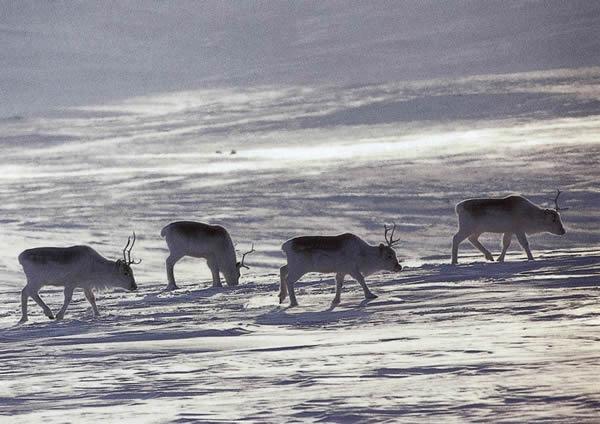North Pole reindeer in danger of extinction
Peary caribou are smaller and whiter than other reindeer, adaptations that help them survive in the northern most latitudes. (Photo by L. David Mech for the National Oceanic and Atmospheric Association via Wikimedia Commons.)
Without his reindeer, Santa’s sleigh would be stuck in park tonight.
There’s a very real possibility, however, that the world’s reindeer population could disappear, says Jeff Flocken, head of U.S. policy for the International Fund for Animal Welfare. Only some reindeer populations, also known as caribou, are especially at risk.
“These are the ones that people probably have in their mind when they thinking of Santa’s reindeer because they’re closest to the North Pole,” Flocken said. “The two species that we’re most concerned with: the peary and the dolphin union populations are the northernmost caribou, and they’re found in northern Canada on Victoria Island, and other islands up there at the top.”
These particular reindeer varieties are probably smaller than what most people think of when picturing a reindeer. The peary light colored, almost white, and have dense fur. The dolphin union are darker and have velvet covering their antlers. Caribou across the globe are in trouble. Living only in the northern latitudes of the Northern Hemisphere, experts think they may have lost 60 percent of their population, from their all-time high.
“These in the most northern part are even in more trouble,” Flocken said. “During the last few winters, they’ve found mass die-offs of the peary ones in particular. Up to 84 percent of the population they think have been lost.”
As usual, this all comes down to climate change. The temperature, weather and landscape are all changing in the Arctic, causing problems for reindeer, as well as for Polar Bears and other animals.
In particular, the North Pole used to have almost exclusively light, fluffy snow. Now, it sees more icy rain, which covers plants that grow in the area and prevents reindeer from eating them during the winter.
“They’re starving or they’re spending too much energy trying to find food. As a result starvation, malnutrition, low-reproductive rates, and that’s causing these die-offs,” Flocken said.
Canada has listed the peary reindeer as endangered, and the dolphin union reindeer as threatened. But Flocken and others want the United States to list them under the Endangered Species Act. He said because climate change will be the leading cause of extinction in our lifetimes, it’s critical that the publicity and attention that comes from a U.S. listing also be brought to bear.
“We’re hoping that the more attention that goes through this, the more people change their habits,” Flocken said. “And the more that the international community tries to address the problem of human climate change.”
Flocken also hopes, eventually, that the U.S. will use the Endangered Species Act as a tool for enforcing pollution controls in the United States. Thus far, neither the Bush or Obama administrations have taken it so far.
“Every time that we learn more about different species that are declining because of climate change, it opens up that opportunity to bring back that discussion,” he said.
